Characterization of LiFePO4 Nanostructures Synthesized by Solvothermal Method
In this work, we have synthesized LiFePO4 particles with the size around 200 nm by solvothermal method.
The crystalline LiFePO4 was synthesized from LiOH.H2O, FeSO4.7H2O and H3PO4 precursors, using
ethylene glycol and water as solvents. Ascorbic acid was added to the solution to prevent oxidation of Fe2+
to Fe3+. The structure was characterized by X-ray diffraction (XRD) and scanning electron microscope
(SEM). Carbon black is determined to reduce the phase structure of Fe3+ remaining in the LiFePO4
composition into Fe2+ after the annealing step. The LiFePO4 particles were also mixed with EC 600JD
carbon black and followed by the annealing at 550 oC for composite formation. Their electrochemical
properties were determined by cyclic voltammetry (CV) and galvanostatic cycling with potential limit
(GCPL).
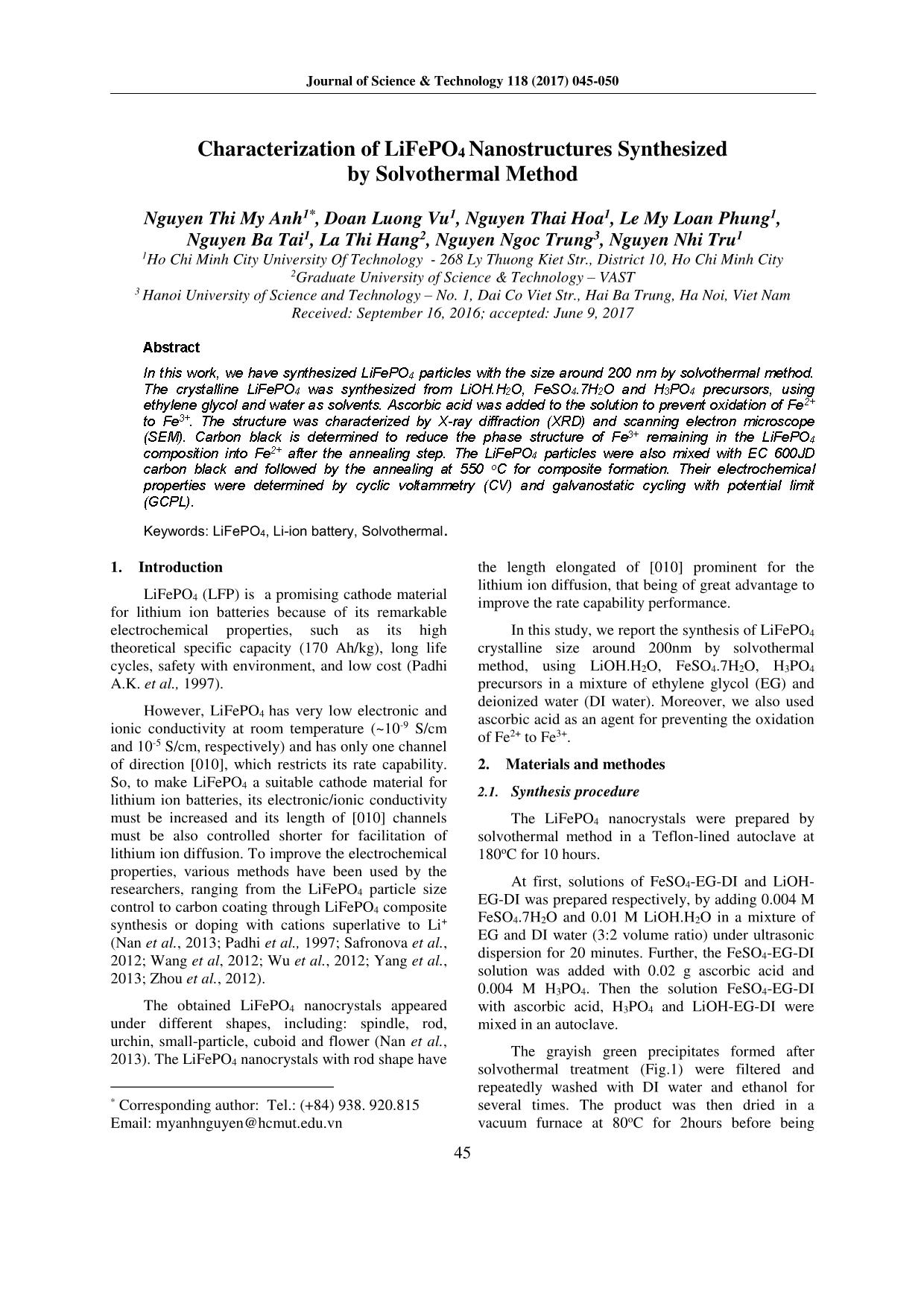
Trang 1
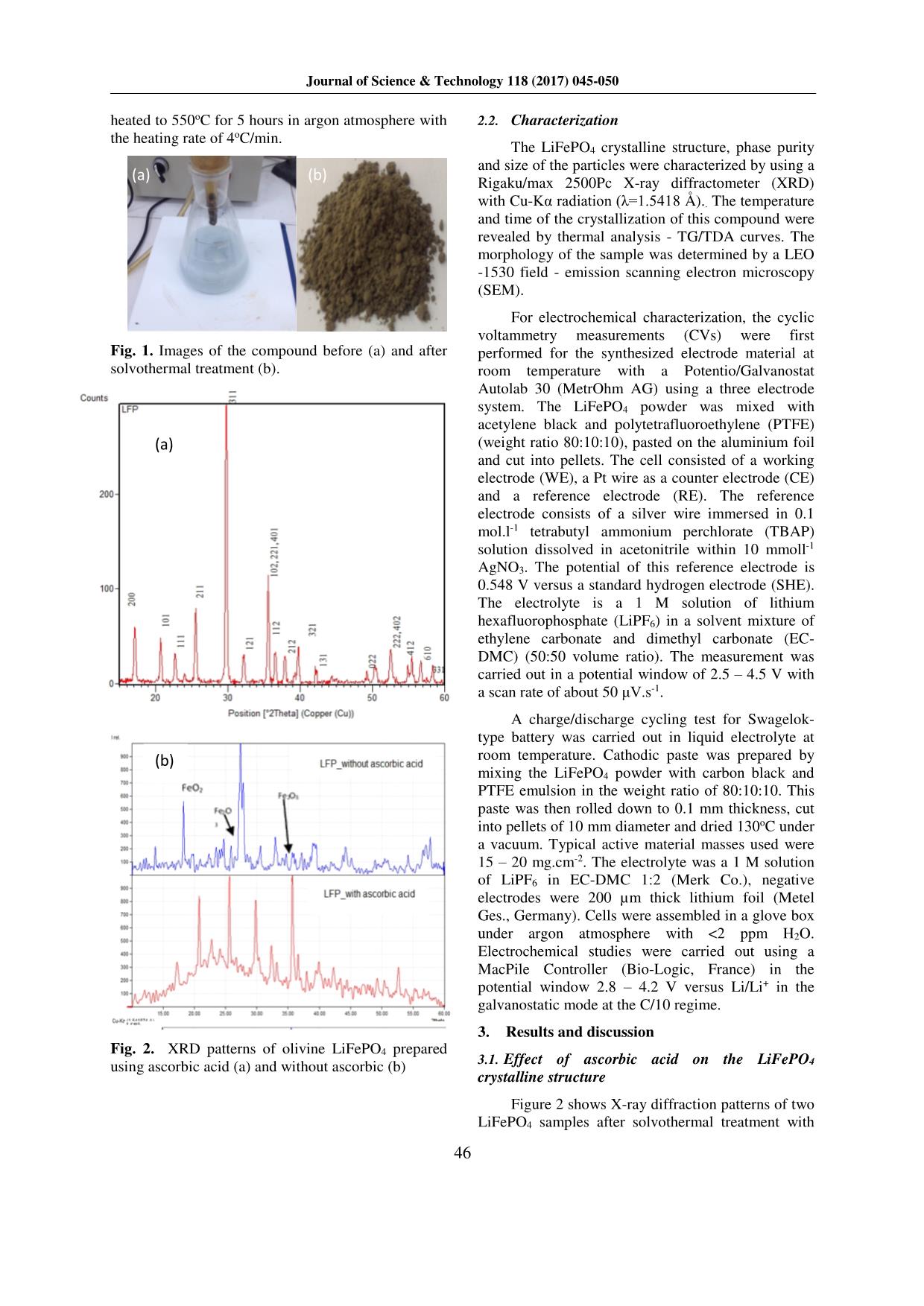
Trang 2
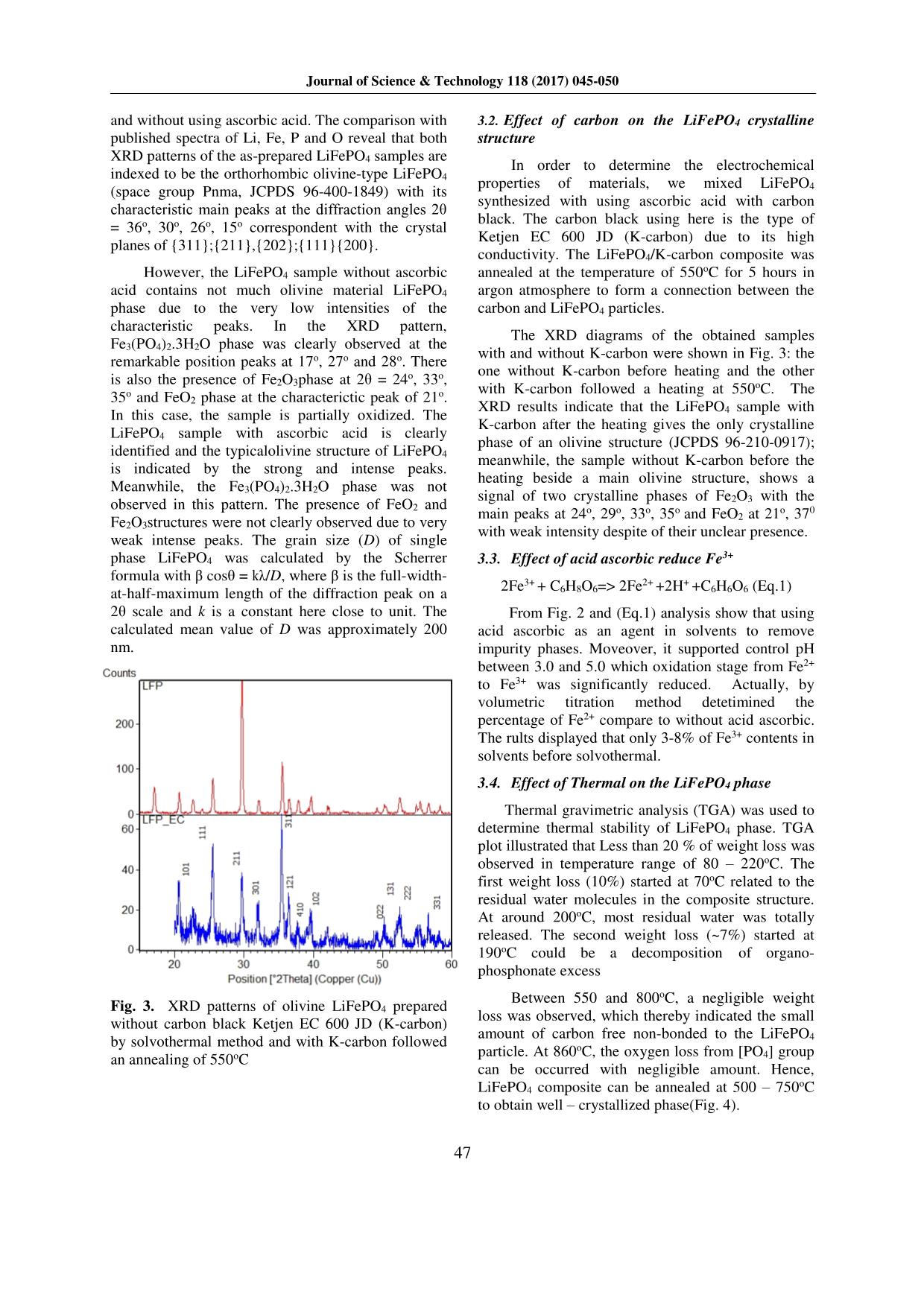
Trang 3
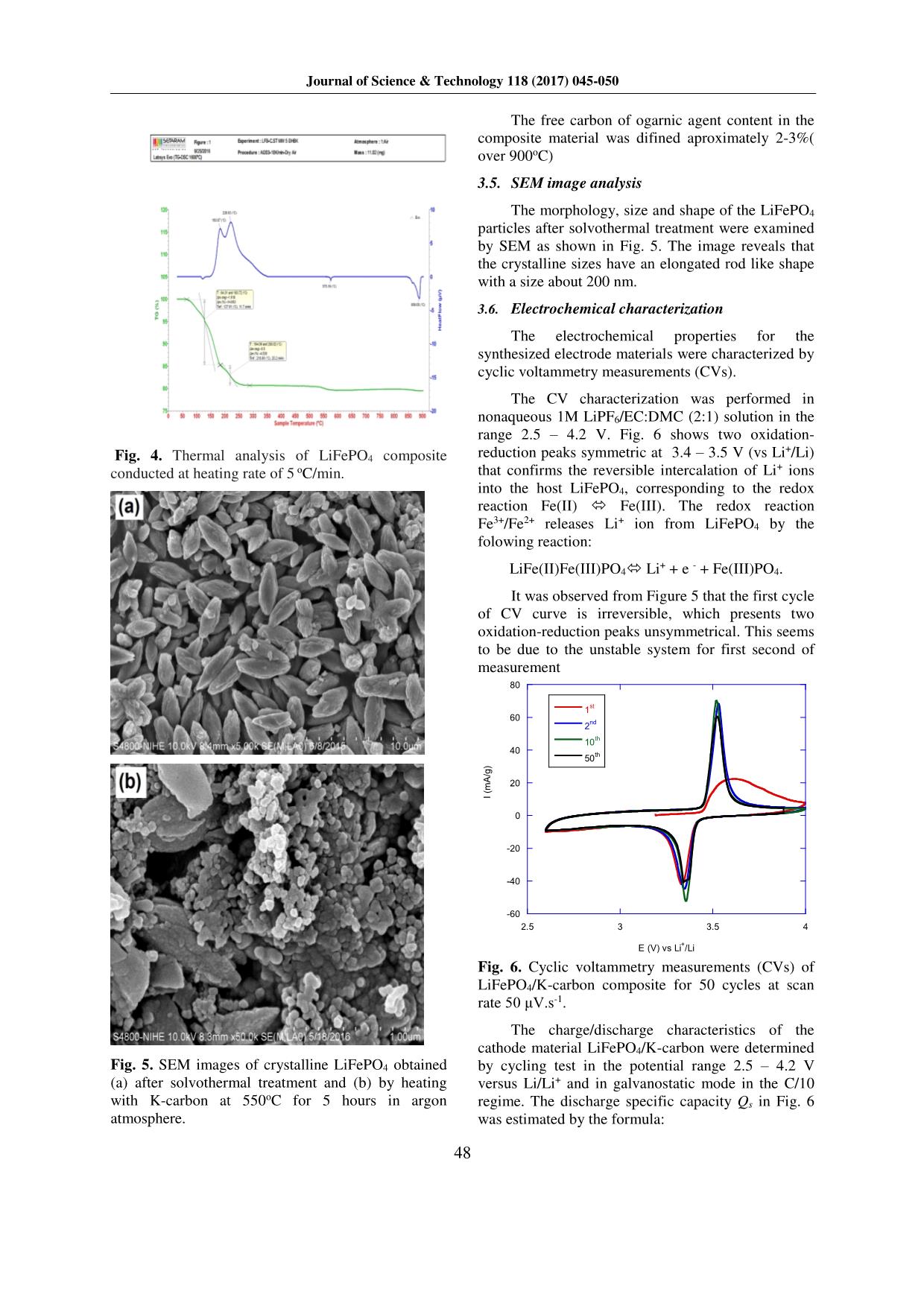
Trang 4
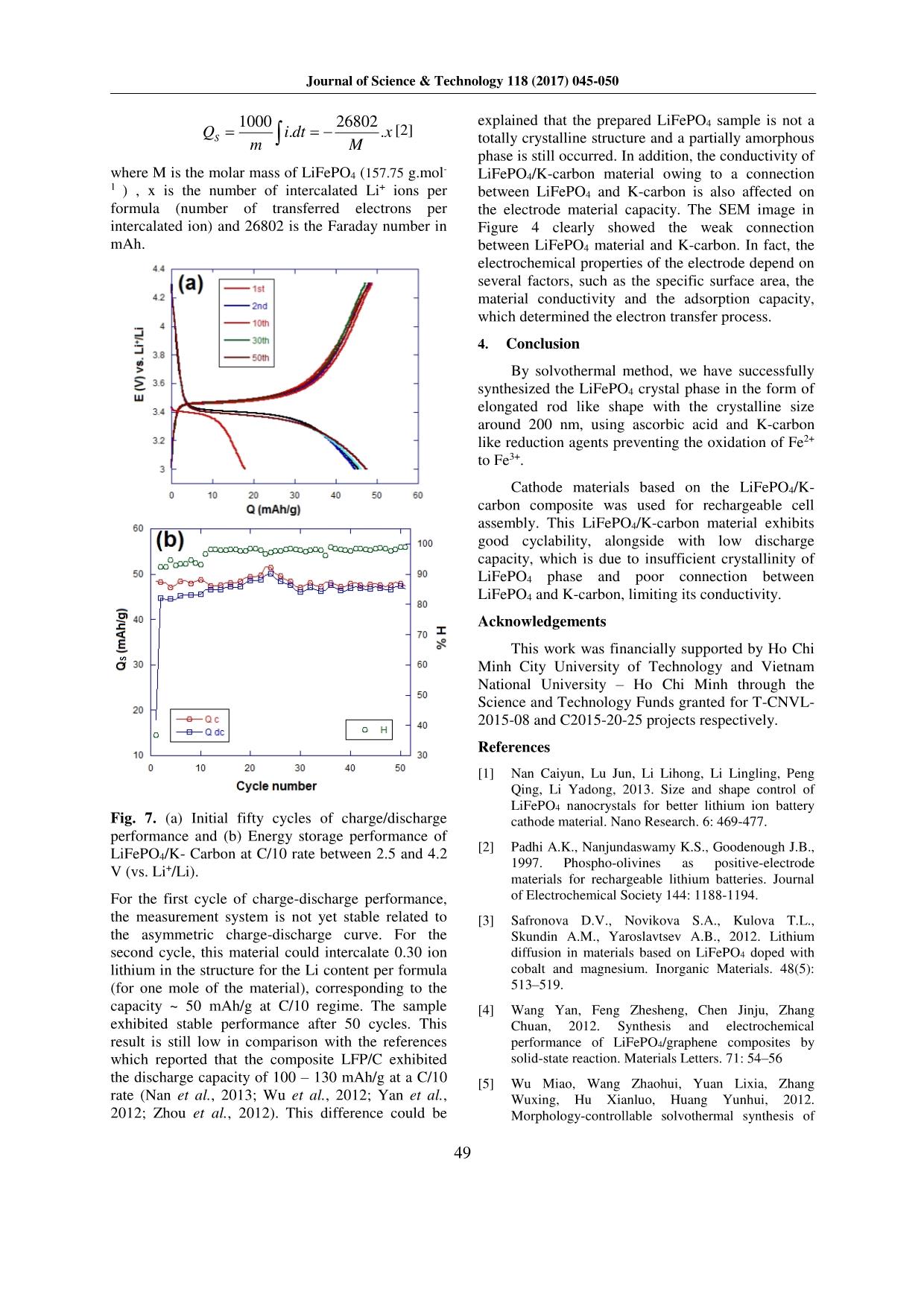
Trang 5

Trang 6
Tóm tắt nội dung tài liệu: Characterization of LiFePO4 Nanostructures Synthesized by Solvothermal Method
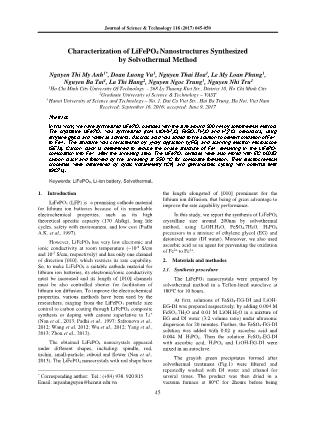
Journal of Science & Technology 118 (2017) 045-050
45
Characterization of LiFePO4 Nanostructures Synthesized
by Solvothermal Method
Nguyen Thi My Anh1*, Doan Luong Vu1, Nguyen Thai Hoa1, Le My Loan Phung1,
Nguyen Ba Tai1, La Thi Hang2, Nguyen Ngoc Trung3, Nguyen Nhi Tru1
1Ho Chi Minh City University Of Technology - 268 Ly Thuong Kiet Str., District 10, Ho Chi Minh City
2Graduate University of Science & Technology – VAST
3 Hanoi University of Science and Technology – No. 1, Dai Co Viet Str., Hai Ba Trung, Ha Noi, Viet Nam
Received: September 16, 2016; accepted: June 9, 2017
Abstract
In this work, we have synthesized LiFePO4 particles with the size around 200 nm by solvothermal method.
The crystalline LiFePO4 was synthesized from LiOH.H2O, FeSO4.7H2O and H3PO4 precursors, using
ethylene glycol and water as solvents. Ascorbic acid was added to the solution to prevent oxidation of Fe2+
to Fe3+. The structure was characterized by X-ray diffraction (XRD) and scanning electron microscope
(SEM). Carbon black is determined to reduce the phase structure of Fe3+ remaining in the LiFePO4
composition into Fe2+ after the annealing step. The LiFePO4 particles were also mixed with EC 600JD
carbon black and followed by the annealing at 550 oC for composite formation. Their electrochemical
properties were determined by cyclic voltammetry (CV) and galvanostatic cycling with potential limit
(GCPL).
Keywords: LiFePO4, Li-ion battery, Solvothermal.
1. Introduction
LiFePO4 (LFP) is* a promising cathode material
for lithium ion batteries because of its remarkable
electrochemical properties, such as its high
theoretical specific capacity (170 Ah/kg), long life
cycles, safety with environment, and low cost (Padhi
A.K. et al., 1997).
However, LiFePO4 has very low electronic and
ionic conductivity at room temperature (~10-9 S/cm
and 10-5 S/cm, respectively) and has only one channel
of direction [010], which restricts its rate capability.
So, to make LiFePO4 a suitable cathode material for
lithium ion batteries, its electronic/ionic conductivity
must be increased and its length of [010] channels
must be also controlled shorter for facilitation of
lithium ion diffusion. To improve the electrochemical
properties, various methods have been used by the
researchers, ranging from the LiFePO4 particle size
control to carbon coating through LiFePO4 composite
synthesis or doping with cations superlative to Li+
(Nan et al., 2013; Padhi et al., 1997; Safronova et al.,
2012; Wang et al, 2012; Wu et al., 2012; Yang et al.,
2013; Zhou et al., 2012).
The obtained LiFePO4 nanocrystals appeared
under different shapes, including: spindle, rod,
urchin, small-particle, cuboid and flower (Nan et al.,
2013). The LiFePO4 nanocrystals with rod shape have
* Corresponding author: Tel.: (+84) 938. 920.815
Email: myanhnguyen@hcmut.edu.vn
the length elongated of [010] prominent for the
lithium ion diffusion, that being of great advantage to
improve the rate capability performance.
In this study, we report the synthesis of LiFePO4
crystalline size around 200nm by solvothermal
method, using LiOH.H2O, FeSO4.7H2O, H3PO4
precursors in a mixture of ethylene glycol (EG) and
deionized water (DI water). Moreover, we also used
ascorbic acid as an agent for preventing the oxidation
of Fe2+ to Fe3+.
2. Materials and methodes
2.1. Synthesis procedure
The LiFePO4 nanocrystals were prepared by
solvothermal method in a Teflon-lined autoclave at
180oC for 10 hours.
At first, solutions of FeSO4-EG-DI and LiOH-
EG-DI was prepared respectively, by adding 0.004 M
FeSO4.7H2O and 0.01 M LiOH.H2O in a mixture of
EG and DI water (3:2 volume ratio) under ultrasonic
dispersion for 20 minutes. Further, the FeSO4-EG-DI
solution was added with 0.02 g ascorbic acid and
0.004 M H3PO4. Then the solution FeSO4-EG-DI
with ascorbic acid, H3PO4 and LiOH-EG-DI were
mixed in an autoclave.
The grayish green precipitates formed after
solvothermal treatment (Fig.1) were filtered and
repeatedly washed with DI water and ethanol for
several times. The product was then dried in a
vacuum furnace at 80oC for 2hours before being
Journal of Science & Technology 118 (2017) 045-050
46
heated to 550oC for 5 hours in argon atmosphere with
the heating rate of 4oC/min.
Fig. 1. Images of the compound before (a) and after
solvothermal treatment (b).
Fig. 2. XRD patterns of olivine LiFePO4 prepared
using ascorbic acid (a) and without ascorbic (b)
2.2. Characterization
The LiFePO4 crystalline structure, phase purity
and size of the particles were characterized by using a
Rigaku/max 2500Pc X-ray diffractometer (XRD)
with Cu-Kα radiation (λ=1.5418 Å).
.
The temperature
and time of the crystallization of this compound were
revealed by thermal analysis - TG/TDA curves. The
morphology of the sample was determined by a LEO
-1530 field - emission scanning electron microscopy
(SEM).
For electrochemical characterization, the cyclic
voltammetry measurements (CVs) were first
performed for the synthesized electrode material at
room temperature with a Potentio/Galvanostat
Autolab 30 (MetrOhm AG) using a three electrode
system. The LiFePO4 powder was mixed with
acetylene black and polytetrafluoroethylene (PTFE)
(weight ratio 80:10:10), pasted on the aluminium foil
and cut into pellets. The cell consisted of a working
electrode (WE), a Pt wire as a counter electrode (CE)
and a reference electrode (RE). The reference
electrode consists of a silver wire immersed in 0.1
mol.l-1 tetrabutyl ammonium perchlorate (TBAP)
solution dissolved in acetonitrile within 10 mmoll-1
AgNO3. The potential of this reference electrode is
0.548 V versus a standard hydrogen electrode (SHE).
The electrolyte is a 1 M solution of lithium
hexafluorophosphate (LiPF6) in a solvent mixture of
ethylene carbonate and dimethyl carbonate (EC-
DMC) (50:50 volume ratio). The measurement was
carried out in a potential window of 2.5 – 4.5 V with
a scan rate of about 50 μV.s-1.
A charge/discharge cycling test for Swagelok-
type battery was carried out in liquid electrolyte at
room temperature. Cathodic paste was prepared by
mixing the LiFePO4 powder with carbon black and
PTFE emulsion in the weight ratio of 80:10:10. This
paste was then rolled down to 0.1 mm thickness, cut
into pellets of 10 mm diameter and dried 130oC under
a vacuum. Typical active material masses used were
15 – 20 mg.cm-2. The electrolyte was a 1 M solution
of LiPF6 in EC-DMC 1:2 (Merk Co.), negative
electrodes were 200 µm thick lithium foil (Metel
Ges., Germany). Cells were assembled in a glove box
under argon atmosphere with <2 ppm H2O.
Electrochemical studies were carried out using a
MacPile Controller (Bio-Logic, France) in the
potential window 2.8 – 4.2 V versus Li/Li+ in the
galvanostatic mode at the C/10 regime.
3. Results and discussion
3.1. Effect of ascorbic acid on the LiFePO4
crystalline structure
Figure 2 shows X-ray diffraction patterns of two
LiFePO4 samples after solvothermal treatment with
(a) (b)
(a)
(b)
Journal of Science & Technology 118 (2017) 045-050
47
and without using ascorbic acid. The comparison with
published spectra of Li, Fe, P and O reveal that both
XRD patterns of the as-prepared LiFePO4 samples are
indexed to be the orthorhombic olivine-type LiFePO4
(space group Pnma, JCPDS 96-400-1849) with its
characteristic main peaks at the diffraction angles 2θ
= 36o, 30o, 26o, 15o correspondent with the crystal
planes of {311};{211},{202};{111}{200}.
However, the LiFePO4 sample without ascorbic
acid contains not much olivine material LiFePO4
phase due to the very low intensities of the
characteristic peaks. In the XRD pattern,
Fe3(PO4)2.3H2O phase was clearly observed at the
remarkable position peaks at 17o, 27o and 28o. There
is also the presence of Fe2O3phase at 2θ = 24o, 33o,
35o and FeO2 phase at the characterictic peak of 21o.
In this case, the sample is partially oxidized. The
LiFePO4 sample with ascorbic acid is clearly
identified and the typicalolivine structure of LiFePO4
is indicated by the strong and intense peaks.
Meanwhile, the Fe3(PO4)2.3H2O phase was not
observed in this pattern. The presence of FeO2 and
Fe2O3structures were not clearly observed due to very
weak intense peaks. The grain size (D) of single
phase LiFePO4 was calculated by the Scherrer
formula with β cosθ = kλ/D, where β is the full-width-
at-half-maximum length of the diffraction peak on a
2θ scale and k is a constant here close to unit. The
calculated mean value of D was approximately 200
nm.
Fig. 3. XRD patterns of olivine LiFePO4 prepared
without carbon black Ketjen EC 600 JD (K-carbon)
by solvothermal method and with K-carbon followed
an annealing of 550oC
3.2. Effect of carbon on the LiFePO4 crystalline
structure
In order to determine the electrochemical
properties of materials, we mixed LiFePO4
synthesized with using ascorbic acid with carbon
black. The carbon black using here is the type of
Ketjen EC 600 JD (K-carbon) due to its high
conductivity. The LiFePO4/K-carbon composite was
annealed at the temperature of 550oC for 5 hours in
argon atmosphere to form a connection between the
carbon and LiFePO4 particles.
The XRD diagrams of the obtained samples
with and without K-carbon were shown in Fig. 3: the
one without K-carbon before heating and the other
with K-carbon followed a heating at 550oC. The
XRD results indicate that the LiFePO4 sample with
K-carbon after the heating gives the only crystalline
phase of an olivine structure (JCPDS 96-210-0917);
meanwhile, the sample without K-carbon before the
heating beside a main olivine structure, shows a
signal of two crystalline phases of Fe2O3 with the
main peaks at 24o, 29o, 33o, 35o and FeO2 at 21o, 370
with weak intensity despite of their unclear presence.
3.3. Effect of acid ascorbic reduce Fe3+
2Fe3+ + C6H8O6=> 2Fe2+ +2H+ +C6H6O6 (Eq.1)
From Fig. 2 and (Eq.1) analysis show that using
acid ascorbic as an agent in solvents to remove
impurity phases. Moveover, it supported control pH
between 3.0 and 5.0 which oxidation stage from Fe2+
to Fe3+ was significantly reduced. Actually, by
volumetric titration method detetimined the
percentage of Fe2+ compare to without acid ascorbic.
The rults displayed that only 3-8% of Fe3+ contents in
solvents before solvothermal.
3.4. Effect of Thermal on the LiFePO4 phase
Thermal gravimetric analysis (TGA) was used to
determine thermal stability of LiFePO4 phase. TGA
plot illustrated that Less than 20 % of weight loss was
observed in temperature range of 80 – 220oC. The
first weight loss (10%) started at 70oC related to the
residual water molecules in the composite structure.
At around 200oC, most residual water was totally
released. The second weight loss (~7%) started at
190oC could be a decomposition of organo-
phosphonate excess
Between 550 and 800oC, a negligible weight
loss was observed, which thereby indicated the small
amount of carbon free non-bonded to the LiFePO4
particle. At 860oC, the oxygen loss from [PO4] group
can be occurred with negligible amount. Hence,
LiFePO4 composite can be annealed at 500 – 750oC
to obtain well – crystallized phase(Fig. 4).
Journal of Science & Technology 118 (2017) 045-050
48
Fig. 4. Thermal analysis of LiFePO4 composite
conducted at heating rate of 5 oC/min.
Fig. 5. SEM images of crystalline LiFePO4 obtained
(a) after solvothermal treatment and (b) by heating
with K-carbon at 550oC for 5 hours in argon
atmosphere.
The free carbon of ogarnic agent content in the
composite material was difined aproximately 2-3%(
over 900oC)
3.5. SEM image analysis
The morphology, size and shape of the LiFePO4
particles after solvothermal treatment were examined
by SEM as shown in Fig. 5. The image reveals that
the crystalline sizes have an elongated rod like shape
with a size about 200 nm.
3.6. Electrochemical characterization
The electrochemical properties for the
synthesized electrode materials were characterized by
cyclic voltammetry measurements (CVs).
The CV characterization was performed in
nonaqueous 1M LiPF6/EC:DMC (2:1) solution in the
range 2.5 – 4.2 V. Fig. 6 shows two oxidation-
reduction peaks symmetric at 3.4 – 3.5 V (vs Li+/Li)
that confirms the reversible intercalation of Li+ ions
into the host LiFePO4, corresponding to the redox
reaction Fe(II) Fe(III). The redox reaction
Fe3+/Fe2+ releases Li+ ion from LiFePO4 by the
folowing reaction:
LiFe(II)Fe(III)PO4 Li+ + e - + Fe(III)PO4.
It was observed from Figure 5 that the first cycle
of CV curve is irreversible, which presents two
oxidation-reduction peaks unsymmetrical. This seems
to be due to the unstable system for first second of
measurement
-60
-40
-20
0
20
40
60
80
2.5 3 3.5 4
LFP 550oC
1st
2nd
10th
50th
I (
m
A/
g)
E (V) vs Li+/Li
Fig. 6. Cyclic voltammetry measurements (CVs) of
LiFePO4/K-carbon composite for 50 cycles at scan
rate 50 μV.s-1.
The charge/discharge characteristics of the
cathode material LiFePO4/K-carbon were determined
by cycling test in the potential range 2.5 – 4.2 V
versus Li/Li+ and in galvanostatic mode in the C/10
regime. The discharge specific capacity Qs in Fig. 6
was estimated by the formula:
Journal of Science & Technology 118 (2017) 045-050
49
xMdtimQS .26802.1000 [2]
where M is the molar mass of LiFePO4 (157.75 g.mol-
1 ) , x is the number of intercalated Li+ ions per
formula (number of transferred electrons per
intercalated ion) and 26802 is the Faraday number in
mAh.
Fig. 7. (a) Initial fifty cycles of charge/discharge
performance and (b) Energy storage performance of
LiFePO4/K- Carbon at C/10 rate between 2.5 and 4.2
V (vs. Li+/Li).
For the first cycle of charge-discharge performance,
the measurement system is not yet stable related to
the asymmetric charge-discharge curve. For the
second cycle, this material could intercalate 0.30 ion
lithium in the structure for the Li content per formula
(for one mole of the material), corresponding to the
capacity ~ 50 mAh/g at C/10 regime. The sample
exhibited stable performance after 50 cycles. This
result is still low in comparison with the references
which reported that the composite LFP/C exhibited
the discharge capacity of 100 – 130 mAh/g at a C/10
rate (Nan et al., 2013; Wu et al., 2012; Yan et al.,
2012; Zhou et al., 2012). This difference could be
explained that the prepared LiFePO4 sample is not a
totally crystalline structure and a partially amorphous
phase is still occurred. In addition, the conductivity of
LiFePO4/K-carbon material owing to a connection
between LiFePO4 and K-carbon is also affected on
the electrode material capacity. The SEM image in
Figure 4 clearly showed the weak connection
between LiFePO4 material and K-carbon. In fact, the
electrochemical properties of the electrode depend on
several factors, such as the specific surface area, the
material conductivity and the adsorption capacity,
which determined the electron transfer process.
4. Conclusion
By solvothermal method, we have successfully
synthesized the LiFePO4 crystal phase in the form of
elongated rod like shape with the crystalline size
around 200 nm, using ascorbic acid and K-carbon
like reduction agents preventing the oxidation of Fe2+
to Fe3+.
Cathode materials based on the LiFePO4/K-
carbon composite was used for rechargeable cell
assembly. This LiFePO4/K-carbon material exhibits
good cyclability, alongside with low discharge
capacity, which is due to insufficient crystallinity of
LiFePO4 phase and poor connection between
LiFePO4 and K-carbon, limiting its conductivity.
Acknowledgements
This work was financially supported by Ho Chi
Minh City University of Technology and Vietnam
National University – Ho Chi Minh through the
Science and Technology Funds granted for T-CNVL-
2015-08 and C2015-20-25 projects respectively.
References
[1] Nan Caiyun, Lu Jun, Li Lihong, Li Lingling, Peng
Qing, Li Yadong, 2013. Size and shape control of
LiFePO4 nanocrystals for better lithium ion battery
cathode material. Nano Research. 6: 469-477.
[2] Padhi A.K., Nanjundaswamy K.S., Goodenough J.B.,
1997. Phospho-olivines as positive-electrode
materials for rechargeable lithium batteries. Journal
of Electrochemical Society 144: 1188-1194.
[3] Safronova D.V., Novikova S.A., Kulova T.L.,
Skundin A.M., Yaroslavtsev A.B., 2012. Lithium
diffusion in materials based on LiFePO4 doped with
cobalt and magnesium. Inorganic Materials. 48(5):
513–519.
[4] Wang Yan, Feng Zhesheng, Chen Jinju, Zhang
Chuan, 2012. Synthesis and electrochemical
performance of LiFePO4/graphene composites by
solid-state reaction. Materials Letters. 71: 54–56
[5] Wu Miao, Wang Zhaohui, Yuan Lixia, Zhang
Wuxing, Hu Xianluo, Huang Yunhui, 2012.
Morphology-controllable solvothermal synthesis of
Journal of Science & Technology 118 (2017) 045-050
50
nanoscale LiFePO4 in a binary solvent. Chinese
Science Bulletin. 57(32): 4170-4175.
[6] Yang Jinli, Wang Jiajun, Tang Yongji, Wang
Dongniu, Li Xifei, Hu Yuhai, Li Ruying, Liang
Guoxian, Sham Tsunkong, Sun Xueliang, 2013.
LiFePO4/graphene as a superior cathode material for
rechargeable lithium batteries: impact of stacked
graphene and unfolded graphene. Energy &
Environmental Science. 6: 1521.
[7] Zhou Nan, Liu Yanyi, Li Jiangang, Uchaker E., Liu
Suqin, Huang Kelong, Cao Guozhong, 2012.
Synthesis and electrochemical properties of
nanocrystalline LiFePO4 obtained by different
methods. Journal of Power Sources. 213: 100-105.
File đính kèm:
 characterization_of_lifepo4_nanostructures_synthesized_by_so.pdf
characterization_of_lifepo4_nanostructures_synthesized_by_so.pdf

